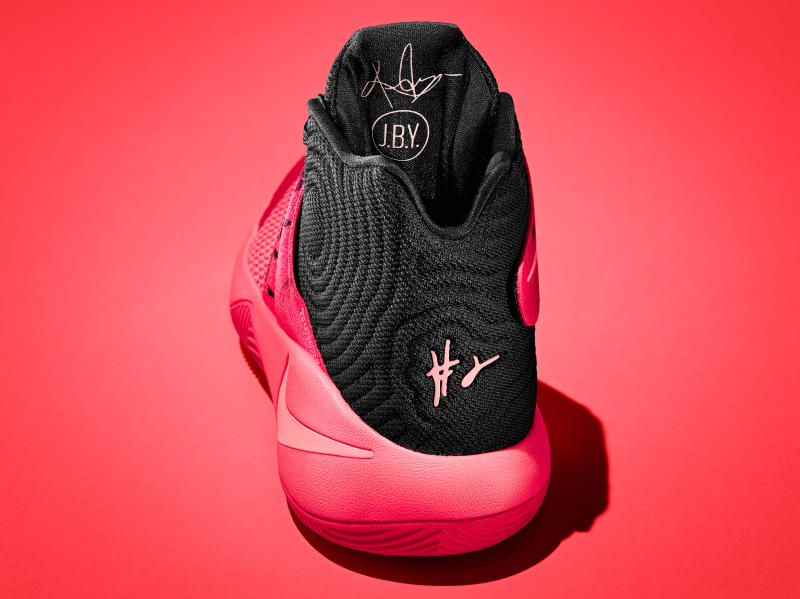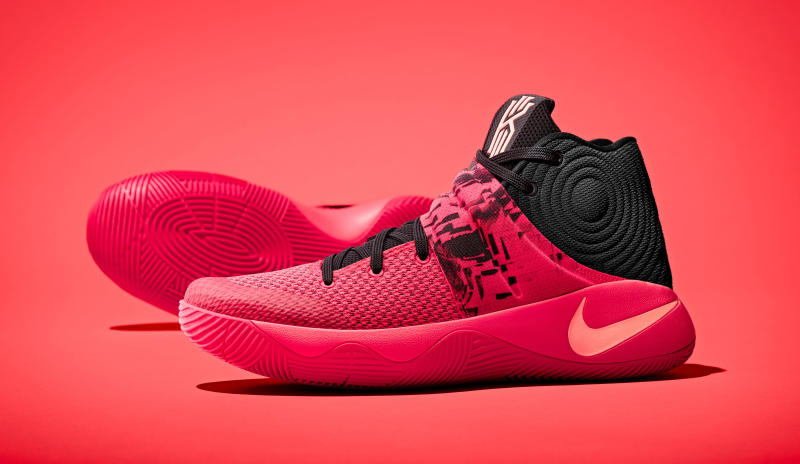
When pictures of the Kyrie 2 first leaked, there was an immediate comparison to a popular model from Nike’s not-so-distant past: the Zoom KD 4. And it’s pretty easy to see why. The shoes share a fairly similar cut, as well as both having a strap that wraps diagonally across the foot, from the medial to lateral side. The visual similarity is really just the beginning.The more you examine Kyrie Irving’s young signature line, the more parallels can be drawn to Kevin Durant’s.
For example, both lines started off as Nike’s most affordable signature basketball offering. They’ve both utilized Zoom Air as primary cushioning. If you want to get really specific, you can even note that the second installment of each line added a strap to the design. Most importantly, both came out swinging, offering not only great playing shoes for the money, but great playing shoes period.
The Kyrie 2 is no exception to this trend, picking up right where its predecessor left off. And while it doesn’t offer any significant new technology over the original, it utilizes tweaks to existing technology to create an identity all its own. The most notable feature is the fully convex nature of the shoe’s midsole and outsole.
Traditionally, sneakers have a flat profile from the medial to lateral sides of their outsole. It could be decoupled, or have any array of break-points, patterns and aesthetic touches, but the overall shape is flat. The Kyrie 2 utilizes a curved design, where the entire outsole of the shoe has a slight radius that increases as it approaches the midsole, and wraps the entire way up until it meets the upper. The reasoning behind this approach is that it allows the foot to plant at more natural angles, allowing faster acceleration and deceleration. The shoe’s designer, Leo Chang, explained it by saying that “It’s almost as if your body weight is bouncing off a ball.”

The sensation is noticeable, but not in a distracting or off-putting way. In fact, it’s very natural, harkening back to adidas’ Feet You Wear technology in some aspects, thanks to the increased radius on the outsole-to-midsole transition. But where Feet You Wear could feel lumpy and clunky, the Kyrie 2’s transition is silky smooth.
In the simplest terms, what this all means for the wearer is supreme stability. There’s no angle in which you can plant that doesn’t feel natural and secure. I found myself playing harder and cutting sharper just because it felt so safe and reassuring to do so. The way the midsole design wraps up so high has the added benefit of acting as a counter, or foot bucket, keeping you firmly over the footbed and not allowing any lateral movement. I certainly can’t reap the benefits as much as an athlete like Irving can, but I can appreciate the sense of awareness and court feel it provides.
The traction only adds to the sensation. It took a few wears to fully break in, but once it did, grip proved to be excellent. We’ve seen similar details in the past of wrapping the traction up the midsole–it’s been used in Chris Paul’s signature line for years, and we even saw it on Irving’s original signature model. But when combined with the curved outsole, it feels more complete than ever before.

Due to Zoom bags being flat and the footbed being curved, there’s no forefoot Zoom in the Kyrie 2, with its only Air unit being found in the heel. I typically prefer my Zoom in the forefoot, but still found the overall cushioning to be an acceptable compromise. The shoe was designed for speed, not maximum impact protection, and you’re pretty much always going to sacrifice some level of cushioning when providing this high level of court feel.
The shoe’s upper further aids its lockdown and stability. The most obvious source of this comes from the strap, which Chang says was “designed to suck your heel back into the shoe and keep it secure, whether you’re accelerating or decelerating.” What’s less obvious, at least from the outside, is the expertly carved collar padding in the heel. The Zoom Kobe 4 set the precedent for this feature, noting that ankle support is all about controlling the heel, and the Kyrie 2 places a similar importance on the matter. Either feature, the strap or the collar padding, would have probably done the job, but the combination of the two is just outstanding.

The shoe is so stable that I found its collar height—roughly an inch higher than the Kyrie 1's—to be unnecessary and at times uncomfortable. For me, it didn’t have the proprioceptive benefits of a high, nor offer the range-of-motion benefits of a low, instead hitting awkwardly on my ankle and rubbing on my malleolus. I also found some rubbing where the tongue was overlapped by the collar. Notching in the padding of the collar, or a thinner seam on the edges of the tongue could have been helpful. But on the bright side, the shoe’s traditional tongue and upper construction was a welcome change of pace from the full-on bootie method we’ve seen recently from Nike, offering a much more dynamic fit system.
My only other complaint about the shoe relates to the strap, or more specifically, it’s Velcro closure system. The shoe’s laces are the perfect mate to the Velcro, and consistently got stuck in it, fraying the lace material worse and worse every I had to rip it off. This didn’t ultimately hurt the integrity of the laces, and likely won’t since it happened to the ends rather than the lower down where they actually contact the eyelets, but it was an inconvenience that could be easily remedied by a different type of lace.
Comparing Kyrie’s signature line to the early days of KD’s is a major compliment. They’ve both utilized their own takes on tried and true performance technologies, which has helped keep prices down, while still offering enough signature aesthetic touches to make them feel special. They may lack the innovation that a line like Kobe Bryant’s is known for, but that’s not always a bad thing. And while “lacking innovation” may seem like a knock, there’s a time and a place for everything. As KD’s line matured, got more innovative, and more expensive, it’s at times come at the expense of performance. When not properly aligned, a tweaked take on “tried and true” can easily top “new and innovative.”

Grade Breakout
Best For: players looking for a fast and stable shoe, who don’t need maximum impact protection
Colorway Tested: Multi-color/Black/Sail
Key Tech: heel Zoom Air; midfoot strap; Hyperfuse construction; curved midsole and outsole
Sizing: Run a half size small.
Pros: Court feel, stability, speed
Cons: Collar height hits uncomfortably on the ankle.
Buying Advice: For $120, the Kyrie 2 is a no-brainer for guards. It will work for a lot of other players too, as long as cushioning isn’t priority number-one. The shoe’s innovations are subtle, but combine to create shoe that’s lightning quick with rock solid stability. Even though it’s affordable by today’s pricing standards, it’s among the year’s best choices at any price level.

